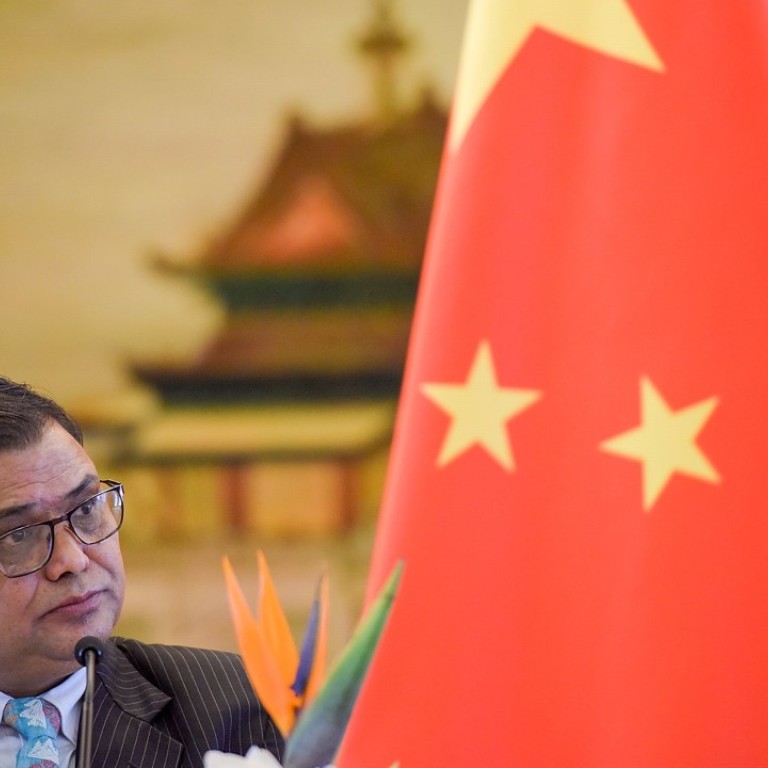
Nepal’s role in China’s Belt and Road Initiative highlights balancing act between Beijing and Delhi
Despite recent tensions in the region, the country’s interests can be best served by acting as a bridge between two giant neighbours
The six-day visit to China by Nepal’s Deputy Prime Minister and Foreign Minister Krishna Bahadur Mahara concluded with a number of agreements – most notably a deal to step up plans for a trans-Himalayan rail link – as Kathmandu seeks to deepen its economic ties with Beijing.
The growing links between the two have concerned India, Nepal’s other giant neighbour, and some have seen them as a counterbalance to India’s dominance in the region.
Historically, Nepal has tried to maintain a balance between the two and remain neutral when they come into conflict.
The recent Doklam stand-off was of immense concern for Nepal as it has ambitions of developing itself into a vibrant bridge between these two Asian giants.
Following the recent dispute, China and India are seemingly less enthusiastic on building direct connections between them but Nepal can play a role as a catalyst in bringing them together.
In this regard, Nepal can also avoid a “zero-sum game” that might force it to choose between China and India.
China’s Belt and Road Initiative is the key to developing closer ties with Nepal and it was against this backdrop that Mahara made his visit to China, where he met Premier Li Keqiang, Foreign Minister Wang Yi and State Councillor Yang Jiechi.
Both Beijing and Kathmandu restated their commitment to previous agreements on developing cross-border economic and transport links.
Since 2015, when it introduced a new constitution as part of the process to end the country’s civil war, Nepal has been committed to taking part in the Belt and Road Initiative.
The signing of a memorandum of understanding between Kathmandu and Beijing has laid a new foundation for Nepal-China ties.
Despite of India’s opposition to the initiative, Nepal’s choice to sign up for China’s infrastructure project has offered it alternative development opportunities.
China has not shown too much concern about New Delhi’s stance and has indicated it will continue trans-Himalayan development with or without India.
Nepal’s involvement in the Belt and Road Initiative has strong support across the political spectrum and from the public.
Although its internal politics has delayed the signing of key agreements, Nepal has been trying to find a pragmatic and balanced way of integrating itself into the initiative and working out how best to leverage the optimal benefits from the Chinese initiative.

Nepal is not regarded as a key country in the Belt and Road Initiative, which means China has had to consider the best way of integrating it into the project.
Its options include establishing a joint mechanism to develop further projects and examine their economic viability to ensure Nepal does not fall into a debt trap by borrowing to invest in schemes that do not offer sufficient economic benefits.
Although Nepal and China’s recent agreements have highlighted the economic aspects of regional cooperation there has been some scepticism about the feasibility or potential benefits of some of the proposals.
The primary source of such scepticism comes from geopolitical sensitivities rather than technical or economic considerations.
Despite lingering differences on certain issues, Nepal’s relationships with both its immediate neighbours have created multiple bonds and it is unlikely that it would want to go against their interests in the region.
Nepal cannot alter its geography; therefore, it has to emphasise its policy of keeping an equal proximity to the two.

Nepal has indicated it would support proposals by either country that will help the Nepalese economy to globalise.
Aside from China’s initiative Nepal is also cooperating with Indian-led multilateral and sub-regional initiatives such as the Bangladesh, Bhutan, India and Nepal project and the Bay of Bengal Initiative for Multi-Sectoral Technical and Economic Cooperation.
Moreover, intensive cooperation and has always been an effective approach towards mitigating geopolitical rivalries in the region.
But any kind of convergence or policy divergence between China and India will always arouse fear and anxiety among their neighbours.
Rupak Sapkota is the general secretary of the Nepal Institute of Strategic Analyses
